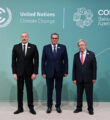Emerging ‘Extreme Heat Belt’ Will Impact Over 107 Million Americans by 2053 (NGO)
Washington – A total of 1,023 US counties are expected to exceed temperatures above 125°F by 2053, the First Street Foundation said Monday in a report.
The report identifies the impact of increasing temperatures at a property level, and how the frequency, duration, and intensity of extremely hot days will change over the next 30 years from a changing climate.
The Foundation’s analysis combines high-resolution measurements of land surface temperatures, canopy cover, impervious surfaces, land cover, and proximity to water to calculate the current heat exposure, and then adjusts for future forecasted emissions scenarios.
This allows for the determination of the number of days any property would be expected to experience dangerous levels of heat.
The model highlights the local impacts of climate change by identifying the seven hottest days expected for any property this year, and using that metric to calculate how many of those days would be experienced in 30 years.
The most severe shift in local temperatures is found in Miami-Dade County where the 7 hottest days, currently at 103°F, will increase to 34 days at that same temperature by 2053.
Across the country, on average, the local hottest 7 days are expected to become the hottest 18 days by 2053.
In the case of extreme heat, the model finds 50 counties, home to 8.1 million residents, that are expected to experience temperatures above 125°F in 2023, the highest level of the National Weather Services’ heat index.
By 2053,1,023 counties are expected to exceed this temperature, an area that is home to 107.6 million Americans and covers a quarter of the US land area, the document points out.
This emerging area, concentrated in a geographic region the Foundation calls the “Extreme Heat Belt,” stretches from the Northern Texas and Louisiana borders to Illinois, Indiana, and even into Wisconsin.
“Increasing temperatures are broadly discussed as averages, but the focus should be on the extension of the extreme tail events expected in a given year,” said Matthew Eby, founder and CEO of First Street Foundation.
“We need to be prepared for the inevitable, that a quarter of the country will soon fall inside the Extreme Heat Belt with temperatures exceeding 125°F and the results will be dire,” Eby added.
The First Street Foundation is a nonprofit research and technology group working to define America’s growing climate risk.













